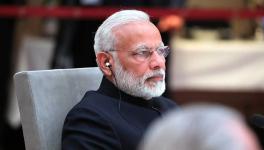Kashmir Files Is a Reminder of Cinema’s History with Hate
Start watching any recent interview of Vivek Agnihotri, and you'll likely find him comparing his film with the iconic Schindler's List. But many believe that Agnihotri's new film, Kashmir Files, is diametrically opposite to it in its values and worldview.
Agnihotri has a very amusing relationship with facts, after all. He had once written a series of desperate tweets complaining to Mumbai Police about people sharing photoshopped tweets under his name. It turned out that they were, in fact, his own tweets. Some were deleted, and some are still present on his timeline.
Researchers and historians are now accusing him of doing through his film what he is criticised for doing through his tweets and videos all along - presenting half-truths to further a hateful agenda.
Ashok Kumar Pandey, historian and writer of Kashmir Aur Kashmiri Pandit: Basne Aur Bikharne Ke 1500 Saal, says that Kashmir Files is an attempt to show some truth, but also an attempt to hide many facts.
"This film rejects the facts of history, hides the truth in the name of telling it and hence commits a crime. And instead of strengthening the chances of peace and resettlement of Kashmiri Pandits, it weakens it. Although the right-wing might benefit from it in the short run, in the long run, such films will create enormous harm to the nation," says Pandey.
The Hate Paradigm
The Islamophobia of this film and its filmmaker is hard to ignore for historians like Pandey. But the film has got an endorsement from the Prime Minister himself, the theatres are jam-packed, and the problems about the politics of this film are hardly discussed openly. Hateful monologues inspired by the film are fearlessly given after screenings across cities and are shared by the makers, including Anupam Kher.
But this normalisation of hate through films has clearly not happened overnight. No matter how much Agnihotri claims his monopoly over this kind of cinema, dog-whistle loaded Hindu-nationalist movies have seen a good rise after 2014. And one genre, in particular, has found great success - Historical Drama. Films like Padmaavat, Tanhaji, Kesari, Panipat were also accused of being Islamophobic by a small section of commentators.
Four years after his last film Padmaavat, Sanjay Leela Bhansali released Alia Bhatt starrer Gangubai Kathiawadi the previous month. It was also recently screened at the 72nd Berlin International Film Festival.
As the press conference at the Berlin Film Festival was about to get over, a journalist asked Bhansali if there were any hindrances while making Gangubai because of "the way India is and how the situations there are."
His last film was released after a long delay due to large protests by the right-wing Hindu organisations. It started with him being maltreated and his set being attacked. Soon there were mobs on the streets causing arson and giving open murder calls for him and his actors. Leaders of the ruling Bharatiya Janata Party (BJP) offered bounties on their heads. Four states banned the film until the Supreme Court overruled it. All four states were governed by the BJP. It was finally released with 300 cuts by the Central Board of Film Certification (CBFC) or the 'Censor Board'.
Before the journalist could complete her question, he responded, "No. Not at all."
He said, "We are in a country where freedom of expression is given its full power. We are never restricted or stopped from saying what we want to, and the creative freedom a filmmaker enjoys in our country is tremendous."
Reasons for such a response are seen as either fully bending to the government's will or willingly extending complete loyalty to the ruling dispensation no matter what they do to him and his film, which is part of a pattern in the industry. His last film Padmaavat, despite all the opposition from some Hindutva groups, was seen in alignment with the ruling dispensation's views on history.
Speaking to Live Mint, Katherine Schofield, senior lecturer in South Asian music and history at King's College London, said these films are important to understand modern values. "We should be reading these films not for what they tell us about the past, but what they tell us about the present."
And experts believe that what is happening in the present is indeed dangerous.
Recently, two credible reports warned that India stands at the risk of genocide. United States Holocaust Memorial Museum, in its The Early Warning Project report, said that India is second-most likely, of all countries in the world, to witness mass killings soon.
Similarly, President of Genocide Watch, Gregory Stanton, while briefing the US Congress, said that early signs were visible and genocide could very well happen against Muslims in India. Stanton is known for foreseeing many genocidal projects and had predicted the 1994 massacre of the 800,000 Tutsi in Rwanda five years before it took place.
During the events that led to that genocide, the media in Rwanda used to pay emphasis on colonial history, spreading worries that Hutus would be oppressed once more if Tutsis took control of Rwanda. These claims were followed by a series of concerted public actions aimed at instilling terror in public.
While watching Kashmir Files, two people sitting in front of me had a nice discussion in the interval on how everyone needs to be cautious that this is not repeated across the country. Some people displayed their oratory skills over this thought and shared their videos. But Agnihotri has been evoking this rhetoric for many years now, including when he said there are many mini Kashmirs made in Shaheen Bagh and northeast Delhi.
To draw such parallels with India can indeed seem to be 'too early'. But that is definitely better than being 'too late'.
Bhansali's Padmaavat was also accused of strengthening every gross stereotype of a present-day Indian Muslim. The costume, set design and cinematography, while shooting the dirty, 'savagely meat-eating Muslim invader' Allauddin Khilji, was a master class in portraying someone as evil in his highest form. There was no subtlety in using Islamic symbolism around him either. In fact, right before he commits one of his brutal crimes, his companion reads verses from the Quran. And, of course, he treats women, including his wife, horribly.
National Award-winning director Neeraj Ghaywan, while speaking about such films in discussion with The Quint, said, "You look at the colour palette, the production design, it is dimly lit and shot in a low angle to make it demonising. But when you show the contrary, it is the opposite, its flowery and bright lights and shot at an eye-level."
The basic plotline of this visual spectacle and one of the highest grossers of the year was that a profoundly barbaric Muslim invader wants to possess the pious Hindu queen of a righteous king and a fearless kingdom. But after that king loses a battle with the 'invader' (by the deceit, of course), the queen, and all the royal women – including a pregnant woman holding the hand of a small girl- self immolates heroically.
One hundred and seven years ago, the first blockbuster of America was released, which is today known for its revolutionary technical innovations but more so for its notorious racist politics – DW Griffith's The Birth of a Nation - also a historical drama with little or no historical accuracy.
Set in the period of Reconstruction, which followed the Civil War, this film portrayed that the enslaved African-Americans didn't deserve to be free and have civil rights. Every frame where an African-American character was shown reflected the immensely hateful view towards them prevalent at the time.
After getting the right to vote in the South, the African Americans in the movie take over the whites, get into the House of Representatives and grab positions of power. Inside its hall, they are shown drinking alcohol, putting bare feet on the table and eating chicken savagely. And then they are all shown turning towards the white women standing in the gallery and slowly giving a lustful smile - because they just passed a bill allowing 'intermarriage of blacks and whites.'
Fear of Sexual Aggression
A few minutes later comes one of the most infamous scenes of the film, a "savage" African-American man stalks a 'pious' White woman, proposes marriage to her, and tries to force himself on her when she refuses. After a small chase sequence, she reaches the cliff of a mountain, and when the man keeps approaching, she decides to kill herself.
In India, a theory like "Love Jihad" getting state approval in the form of Anti-Conversion Laws and causing different forms of violence is seen as a worrying sign. But the theory had obtained the approval of the masses long back.
In one scene of Kashmir Files, a red-bearded character of the Maulavi tries to harass a Kashmiri Pandit woman and proposes marriage. Although I was aware of the bad acting and writing skills at play, my hand slowly went to adjust my mask and hide my beard in an already charged up hall. In the climax, the antagonist suddenly pulls the same Maulvi inside the frame out of nowhere and gets his approval to molest and murder the same woman. The scene is inspired by a horrifying real-life incident, but that flashy red beard in a rather colourless frame made the messaging clear.
Scholars of genocide and hate crimes have often argued how fear of sexual aggression is used as propaganda. It is observed that one of the effective tactics to create hate for a group of people is by forming a narrative that they are 'after the women of our community.' This was liberally used in Nazi propaganda films.
Christiane Schönfeld, head, Department of German Studies at Mary Immaculate College, University of Limerick - writes, "The Jew as sexual beast and vampire, sucking the life spirit from individual and community alike is an all too common motif in anti-Semitic propaganda and is put to effective use in Veit Harlan's film - Jud Suss - a Historical Drama about Duke Karl Alexander of Württemberg and his treasurer Suss Oppenheimer."
According to the writers of Propaganda and Mass Persuasion: A Historical Encyclopedia, Jud Suss was "one of the most notorious and successful pieces of antisemitic film propaganda produced in Nazi Germany."
The film was partially based on a novel by the Jewish writer Lion Feuchtwanger, and both of them had a climax of rape and the victim killing herself.
Incitement Through A Narrative
The character of Suess Oppenheimer was rewritten for the film, sponsored and endorsed by Joseph Goebbels, where he was reduced to a stereotype of Jewish criminals - untrustworthy, greedy, power-hungry and a seducer of Aryan women. The film is believed to fuel antisemitism which led to horrible crimes during the holocaust.
Similarly, The Birth of a Nation is considered responsible for reviving the dead Ku Klux Klan – the white supremacist hateful group. This was because the film not only created hateful stereotypes against African-Americans but also glorified the lynchings by Klansmen who, according to Griffith, 'saved the South from the anarchy of African-American rule.'
And this is where a film like Padmaavat differs from it. Padmaavat does create stigmas but never glorifies any individual or group murdering Muslims. But in a country where the ministers are frequently found doing it themselves, the former is sufficiently dangerous.
When The Birth of a Nation was released, it was advertised in the Atlanta Constitution newspaper. Historians say that William Joseph Simmons - the 'Imperial Wizard' or head organiser of the revived order - placed an announcement beside the film's advertisement and stated the Ku Klux Klan's revival, purpose, and the need for members. When Simmons was interviewed in 1928 and asked that if there had been no film, could he have pushed his new order forward as quickly as he did. Simmon's reply was, "No...The Birth of A Nation helped the Klan tremendously."
And on December 6, 2018 - the anniversary of the greatest turning point for Hindutva politics in India - just days before Padmaavat was released and a few kilometres away from where the movie is set, a horrific hate crime was witnessed. A chilling video went viral from Rajsamand in Rajasthan. A man named Shambhulal Regar had hacked a Muslim labourer Mohammed Afrazul and then burnt him on camera. In all the videos he released, Regar said he killed him to 'save Hindu women from Love Jihad.'
"Agar tumne jihad khatam nahi kiya to ek ek ko aise hi chun chun ke marenge (If you don't stop jihad, we will kill you all like this, one by one)," he said into the mobile camera - that his minor nephew was holding - as he was killing 48-year-old Bengali labourer Afrazul.
The charge sheet against Regar ruled out any angle of Afrazul converting someone or even being in such a relationship. It was later found out that Regar had personal enmity with another Bengali Muslim labourer but killed Afrazul and recorded all those videos to create fear in their community and stop them from migrating in this region.
Two months into the first lockdown, when the entire nation was desperately waiting for a relief package from the government, the prime minister addressed the nation and felt the need to talk about how India was a golden bird many centuries ago, but 'foreign invaders' looted it. This is seen as a classic dog-whistle against the present Muslims. Following this pattern of PM's speeches and all the ahistorical dramas, Kashmir Files also focuses multiple times on how the Kashmir Valley had a 100% Hindu population, but the Muslim Invaders and even Sufis converted and executed them with the force of the sword.
The film has seen an exceptional response from the audience. But the film's critics are also particularly upset by the fact that some very tragic events are used as tools by the maker to further their own prejudices.
The profoundly racist The Birth of a Nation was the highest blockbuster of the US for many years to come. One of the reasons for this was the public acceptance of the film's politics. There were a few protests, but the hate against African-Americans was largely normalised in many parts of the US- so was hate against Jews in Germany, Rohingya Muslims in Myanmar and Tutsis in Rwanda.
Imaad is an Independent Journalist
Get the latest reports & analysis with people's perspective on Protests, movements & deep analytical videos, discussions of the current affairs in your Telegram app. Subscribe to NewsClick's Telegram channel & get Real-Time updates on stories, as they get published on our website.
























